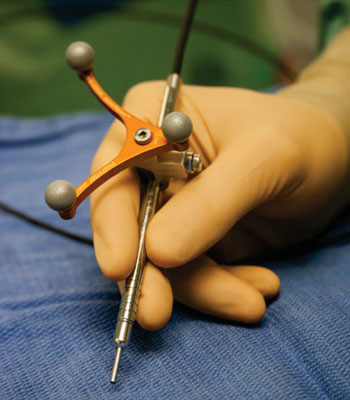Spectroscopic Probe Monitors Hemorrhagic Shock
By HospiMedica International staff writers
Posted on 03 Sep 2015
A novel, noninvasive near-infrared spectroscopy (NIRS) device assesses hemorrhagic shock severity as accurately as a standard blood draw.Posted on 03 Sep 2015
Developed by researchers at the University of Electronic Science and Technology of China (EUSTC; Chengdu, China), the portable probe uses spatially-resolved NIRS (SR-NIRS) to measure tissue blood oxygen saturation (StO2). The probe consists of a triple light emitting diode (LED) that emits light at wavelengths of 735, 805 and 850 nanometers, and two detectors. Since the diameter of each individual detector is only about 0.6 cm, it was impossible to arrange them in a linear pattern, and they were therefore placed in the shape of triangle.

Image: The spatially-resolved NIRS (SR-NIRS) probe (Photo courtesy of EUSTC).
The researchers then used an ultrasound to locate the internal jugular central vein to aid in the placement of SR-NIRS probe, which was then fine-tuned and fixed until the signal became stable. In subsequent tests, noninvasive StO2 measurements were highly correlated with central internal jugular central vein oxygenation level (ScvO2), the current gold standard. The researchers concluded that SR-NIRS device can be used at the bedside for continuous monitoring of shock, and could be used as a clinical tool for shock management. The study was published in the September 2015 issue of Biomedical Optics Express.
“The diffuse reflectance and absorption of the near-infrared light in the tissue is particularly effective at measuring hemoglobin levels, and has seen widespread use as a screening tool for intracranial bleeding,” concluded lead author associate professor Ting Li, PhD, of the electronic thin film and integrated device lab at UESTC, adding that “the standard method to monitor shock is invasive, discontinuous, and time-consuming.”
Current technologies for measuring blood oxygen saturation include peripheral capillary oxygen saturation (SpO2) finger scanners, but as the fingertips are at the periphery of the circulatory system, these can give inaccurate readings for patients with reduced circulation. Using a probe placed near the jugular vein in the neck can allow doctors to continuously monitor a patient's recovery from shock without the need to continuously draw and analyze blood, as in ScvO2.
Related Links:
University of Electronic Science and Technology of China














